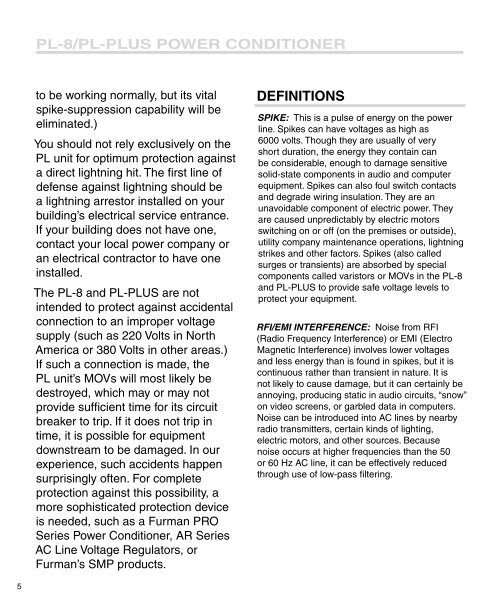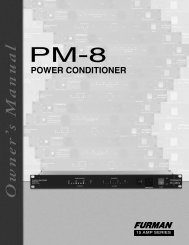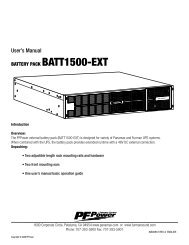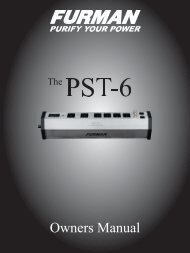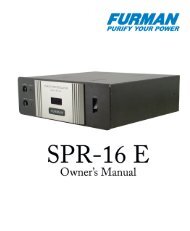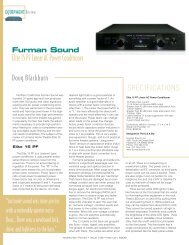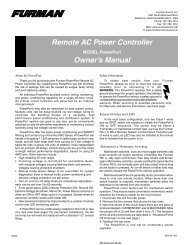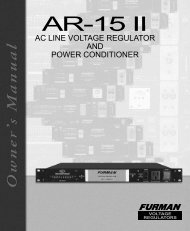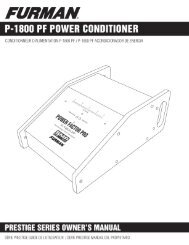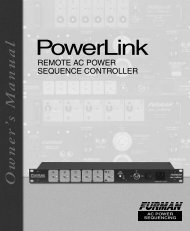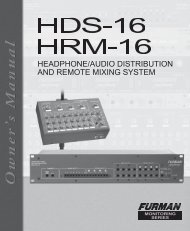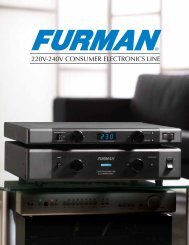PL-8 Manual - Rev C.indd - Furman Sound
PL-8 Manual - Rev C.indd - Furman Sound
PL-8 Manual - Rev C.indd - Furman Sound
You also want an ePaper? Increase the reach of your titles
YUMPU automatically turns print PDFs into web optimized ePapers that Google loves.
5<br />
<strong>PL</strong>-8/<strong>PL</strong>-<strong>PL</strong>US POWER CONDITIONER<br />
to be working normally, but its vital<br />
spike-suppression capability will be<br />
eliminated.)<br />
You should not rely exclusively on the<br />
<strong>PL</strong> unit for optimum protection against<br />
a direct lightning hit. The first line of<br />
defense against lightning should be<br />
a lightning arrestor installed on your<br />
building’s electrical service entrance.<br />
If your building does not have one,<br />
contact your local power company or<br />
an electrical contractor to have one<br />
installed.<br />
The <strong>PL</strong>-8 and <strong>PL</strong>-<strong>PL</strong>US are not<br />
intended to protect against accidental<br />
connection to an improper voltage<br />
supply (such as 220 Volts in North<br />
America or 380 Volts in other areas.)<br />
If such a connection is made, the<br />
<strong>PL</strong> unit’s MOVs will most likely be<br />
destroyed, which may or may not<br />
provide sufficient time for its circuit<br />
breaker to trip. If it does not trip in<br />
time, it is possible for equipment<br />
downstream to be damaged. In our<br />
experience, such accidents happen<br />
surprisingly often. For complete<br />
protection against this possibility, a<br />
more sophisticated protection device<br />
is needed, such as a <strong>Furman</strong> PRO<br />
Series Power Conditioner, AR Series<br />
AC Line Voltage Regulators, or<br />
<strong>Furman</strong>’s SMP products.<br />
DEFINITIONS<br />
SPIKE: This is a pulse of energy on the power<br />
line. Spikes can have voltages as high as<br />
6000 volts. Though they are usually of very<br />
short duration, the energy they contain can<br />
be considerable, enough to damage sensitive<br />
solid-state components in audio and computer<br />
equipment. Spikes can also foul switch contacts<br />
and degrade wiring insulation. They are an<br />
unavoidable component of electric power. They<br />
are caused unpredictably by electric motors<br />
switching on or off (on the premises or outside),<br />
utility company maintenance operations, lightning<br />
strikes and other factors. Spikes (also called<br />
surges or transients) are absorbed by special<br />
components called varistors or MOVs in the <strong>PL</strong>-8<br />
and <strong>PL</strong>-<strong>PL</strong>US to provide safe voltage levels to<br />
protect your equipment.<br />
RFI/EMI INTERFERENCE: Noise from RFI<br />
(Radio Frequency Interference) or EMI (Electro<br />
Magnetic Interference) involves lower voltages<br />
and less energy than is found in spikes, but it is<br />
continuous rather than transient in nature. It is<br />
not likely to cause damage, but it can certainly be<br />
annoying, producing static in audio circuits, “snow”<br />
on video screens, or garbled data in computers.<br />
Noise can be introduced into AC lines by nearby<br />
radio transmitters, certain kinds of lighting,<br />
electric motors, and other sources. Because<br />
noise occurs at higher frequencies than the 50<br />
or 60 Hz AC line, it can be effectively reduced<br />
through use of low-pass filtering.


